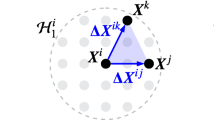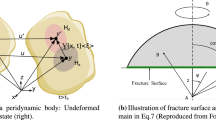Abstract
A non-local formulation of the classical continuum mechanics theory called peridynamics is used to study initiation and propagation of dynamic fractures. The purpose of this study is twofold. First, we introduce a new post-processing technique to estimate stress intensity factors using peridynamic data. Second, the peridynamic stress intensity factors are used to study the influence of loading rate on key aspects of dynamic fracture. In particular attention is focused on examining the influence of loading rate and material properties on time to fracture and the local stress state at the fracture tip during initiation and propagation. In the first part of the paper emphasis is placed on using stress intensity factors to verify the numerical method. Simulations are performed on simplified test cases and the results are compared to relevant experimental and numerical studies found in the literature. Peridynamic stress intensity factors are then used to demonstrate the influence of loading rate on fracture initiation and propagation. To this end simulations are performed by partially loading the internal surfaces of a notch at various loading rates and monitoring the stress intensity at the tip of the notch. For each loading rate, the stress intensity factor increases smoothly to a value above the input fracture toughness at which point initiation occurs. After initiation, the stress intensity factor remains nearly constant in time. It is shown that the stress intensity factor at initiation and the time to fracture depend on the loading rate. Predictions show that the critical stress intensity is insensitive to loading rate when the fracture initiation time is below a material-dependent characteristic time scale. As loading rate increases, the time to fracture decreases and stress intensity at initiation increases markedly. The characteristic time-scale is shown to be only dependent on the material stiffness and independent of the strength of the singularity at the fracture tip. In our simulations, increasing the loading rate resulted in fracture branching. Also, the fracture speed increases with loading rate. However, the dynamic stress intensity factor of a propagating fracture is shown to be independent of loading conditions for a linear peridynamic solid with rate-independent input fracture toughness.



















Similar content being viewed by others
References
Amani J, Oterkus E, Areias P, Zi G, Thoi TN, Rabczuk T (2016) A non-ordinary state-based peridynamics formulation for thermoplastic fracture. Int J Impact Eng 87:83–94
Anderson TL (2005) Fracture mechanics, fundamentals and application. CRC Press, Boca Raton
Batra RC, Ching HK (2002) Analysis of elastodynamic deformations near a crack/notch tip by the meshless local Petrov–Galerkin (MLPG) method. CMES Comp Model Eng 3:717–730
Belytschko T, Chen H, Xu J, Zi G (2003) Dynamic crack propagation based on loss of hyperbolicity and a new discontinuous enrichment. Int J Numer Methods Eng 58:1873–1905
Bitzek E, Koskinen P, Gahler F, Moseler M, Gumbsch P (2006) Structural relaxation made simple. Phys Rev Lett 97:170201–170205
Braun M, Fernandez-Saez J (2014) A new 2D discrete model applied to dynamic crack propagation in brittle materials. Int J Solids Struct 51:3787–3797
Duarte CA, Hazmeh ON, Liszka TJ, Tworzydlo WW (2001) A generalized finite element method for simulation of three-dimensional dynamic crack propagation. Comput Method Appl Mech Eng 190:2227–2262
Dumstroff P, Meschke G (2007) Crack propagation criteria in the framework of X-FEM based structural analyses. Int J Numer Anal Meth Geomech 31:239–259
Freund LB (1990) Dynamic fracture mechanics. Cambridge University Press, Cambridge
Guo Y, Nairn JA (2004) Calculation of J-integral and stress intensity factors using the material point method. CMES Comput Model Eng 6(3):295–308
Ha YD, Bobaru F (2010) Studies of dynamic crack propagation and crack branching with peridynamics. Int J Frac 162:229–244
Ha YD, Bobaru F (2011) Characteristics of dynamic brittle fracture captured with peridynamics. Eng Fract Mech 78:1156–1168
Hu W, Ha YD, Bobaru F, Silling S (2012) The formulation and computation of the nonlocal J-Integral in bond based peridynamics. Int J Frac 176:195–206
Huespe AE, Oliver J, Sanchez PJ, Blanco S (2006) Strong discontinuity approach in dynamic fracture simulations. Mecnica Comput 24:1997–2018
Kalthoff JF, Winkler S (1987) Failure mode transition at high rates of shear loading. In: International conference on impact loading and dynamic behavior of materials Bremen, F.R.G 1:185–195
Kim KS (1985) Dynamic fracture under normal impact loading of the crack faces. J Appl Mech 52:585–592
Kosteski L, DAmbra RB, Iturrioz I (2012) Crack propagation in elastic solids using the truss-like discrete element method. Int J Fract 174:139–161
Liu C, Knauss WG, Rosakis AJ (1998) Loading rates and the dynamic initiation toughness in brittle solids. Int J Fract 90:103–118
Nishioka T, Atluri SN (1983) Path-independent integrals, energy release rates, and general solutions of near-tip fields in mixed-mode dynamic fracture mechanics. Eng Fract Mech 18:1–22
Parks ML, Lehoucq RB, Plimpton SJ, Silling SA (2008) Implementing peridynamics within a molecular dynamics code. Comput Phys Commun 179:777–783
Plimpton S (1995) Fast parallel algorithms for short-range molecular dynamics. J Comput Phys 117(1):1–19
Ravi-Chandar K, Knauss WG (1984) An experimental investigation into dynamic fracture: I. Crack initiation and arrest. Int J Fract 25(4):247–262
Raymond S, Lemiale V, Ibrahim R, Lau R (2014) A meshfree study of the Kalthoff–Winkler experiment in 3D at room and low temperature under dynamic loading using viscoplastic modelling. Eng Anal Bound Elem 42:20–25
Shen B, Stephansson O (2007) Modification of the G-criterion for crack propagation subjected to compression. Eng Fract Mech 47:177–189
Silling SA (2000) Reformulation of elasticity theory for discontinuities and long-range forces. J Mech Phys Solids 48:175–209
Silling SA, Epton M, Weckner O, Xu J (2007) Peridynamic states and constitutive modeling. J Elast 88:151–184
Silling SA, Lehoucq RB (2008) Convergence of peridynamics to classical elasticity theory. J Elast 93:13–37
Silling SA, Lehoucq RB (2010) Peridynamic theory of solid mechanics. Adv Appl Mech 44:73–168
Smith GC (1975) An experimental investigation of the dynamic fracture of a brittle material. Dissertation, California Institute of Technology
Song JH, Wang H, Belytschko T (2008) A comparative study on finite element methods for dynamic fracture. Comput Mech 42:239–250
Acknowledgments
The authors would like to thank ExxonMobil Research and Engineering for supporting this research and permitting us to publish this work.
Author information
Authors and Affiliations
Corresponding author
Rights and permissions
About this article
Cite this article
Panchadhara, R., Gordon, P.A. Application of peridynamic stress intensity factors to dynamic fracture initiation and propagation. Int J Fract 201, 81–96 (2016). https://doi.org/10.1007/s10704-016-0124-8
Received:
Accepted:
Published:
Issue Date:
DOI: https://doi.org/10.1007/s10704-016-0124-8




